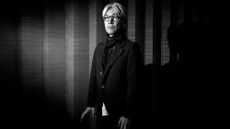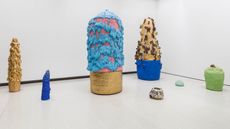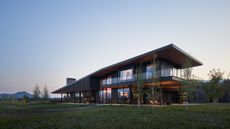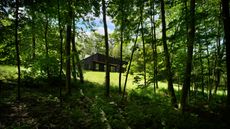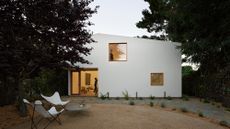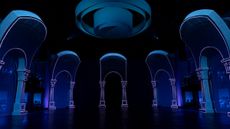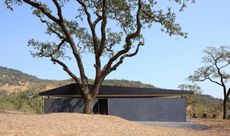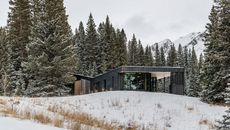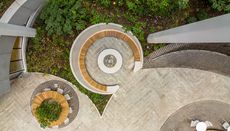At home with Deborah Berke
Architect Deborah Berke talks to us about art, collaboration, climate change and the future, from the living room of her Long Island home
- (opens in new tab)
- (opens in new tab)
- (opens in new tab)
- Sign up to our newsletter Newsletter
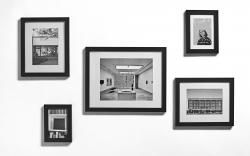
Not only is architect Deborah Berke one of her field’s leading professionals and an instantly recognised name in worldwide design, she was also the subject of the very first architecture story in Wallpaper* – when the magazine launched in 1996. In similar fashion, we kick off the architectural element of our ‘At home with’ interview series by hearing from this renowned American, who shares with us insights, hopes, dreams and inspiration. Berke, who has worked as an architect since 1982, is now the head of her eponymous practice as well as the dean of the Yale School of Architecture – the first woman to ever hold this position. Her career has always blended teaching and practising, as well as art, luxury and minimalism, with key works including the Marianne Boesky Gallery and the interiors at 432 Park Avenue, both in New York City, the Irwin Union Bank in Columbus, and a wealth of private homes.
At home with Deborah Berke

Deborah Berke.
W*: Where are you at the moment? What can you see?
Deborah Berke: In the living room in my house on the eastern end of Long Island. From the couch where I often read, and sometimes sleep, I can see beautiful trees and starkly crisp bright blue sky. When I first envisioned this room while designing the house, I wanted to capture the long horizontal expanse of green and the everchanging edge it makes with the sky above. I continue to cherish that view.
W*: What’s the last thing you bought?
DB: I recently bought a small painting by the Trinidadian-American artist Allana Clarke. I absolutely love it. Allana was recently a fellow at NXTHVN, the artists’ residency and mentorship programme founded by Titus Kaphar, for which we designed the building. So that connection makes it even more meaningful to me.

NXTHVN Gallery
W*: Where and when do you find you are most productive?
DB: Early in the morning when the sun is bright and the sky is blue. I crave natural light and long views – they don’t have to be of anything beautiful or recognisable, they just have to have significant distance. I work best near a window on a big open surface, so I can arrange my digital devices and have paper and a variety of implements with which to draw.
W*: Favourite place, anywhere in the world? And why?
DB: I have endless favourite places, really anywhere I can take a long walk and discover something. I love leaving a hotel and finding streets, shops, restaurants, parks, buildings and activities that are new to me. When we design hotels, we always try and key into the local culture, to celebrate, elevate, and connect to it in a contemporary way.

NXTHVN Gallery.
W*: What’s the one thing (in your creative field) you wish you had designed or invented?
DB: A contemplative space, like a Quaker meeting house or a temple.
W*: Ten years from now you’ll be…
DB: I’ll still be an architect.
W*: What are you reading, and what do you think of it?
DB: I read lots of things simultaneously on a broad range of subjects. Iwan Baan just gave me the new book he did with Frances Kéré. I admire both of their work so much. I’m also reading a novel by Shirley Hazzard, The Great Fire. I recently bought This is Where We Find Ourselves by Njaimeh Njie, which documents the displacement of the Black community in Pittsburgh. I’m also reading Capote’s Women by Laurence Leamer, which is gossipy and fun.

21c Museum Hotel Oklahoma City.
W*: What’s inspiring you right now?
DB: Fear for the planet. It’s hard for architects to have an impact on war or hunger or other global issues, but we have a big role to play in combatting the climate crisis. We do a lot of adaptive reuse projects, and we’ve recently been analysing the embodied carbon we’ve saved in some of our recent projects, and, honestly, the numbers are really incredible. So adaptive reuse is a very powerful tool in fighting climate change.
W*: How do you switch off? Do you switch off?
DB: I swim.
W*: Favourite material to work with and why?
DB: I like all materials, particularly natural materials. I just want them to be honest, and I love when they’re detailed in an interesting or unexpected way.

Art piece by Allana Clarke
W*: What one piece of advice would you give for the next generation?
DB: Stay engaged. Keep your eyes trained on the just future your generation is fighting for and work to build it.
W*: What’s been your biggest failure and what did it teach you?
DB: Architecture is always a bit of a highwire act, so I think there’s always a bit of fear of failure. I use that as motivation to be as rigorous as I can.

Long Island house.
W*: Who is your dream collaborator?
DB: We love working with artists, so working with Titus Kaphar on NXTHVN was a dream project. We hope to collaborate again. And I look forward to working with other artists on projects we can’t even imagine yet.
W*: If you weren’t an architect, what would you have been?
DB: An architect is all I ever wanted to be, so I can’t imagine anything else, in this life at least.
INFORMATION
dberke.com (opens in new tab)
Ellie Stathaki is the Architecture Editor at Wallpaper*. She trained as an architect at the Aristotle University of Thessaloniki in Greece and studied architectural history at the Bartlett in London. Now an established journalist, she has been a member of the Wallpaper* team since 2006, visiting buildings across the globe and interviewing leading architects such as Tadao Ando and Rem Koolhaas. Ellie has also taken part in judging panels, moderated events, curated shows and contributed in books, such as The Contemporary House (Thames & Hudson, 2018) and Glenn Sestig Architecture Diary (2020).
-
 Watch Ryuichi Sakamoto's mesmerising musical experience at the Brooklyn Museum
Watch Ryuichi Sakamoto's mesmerising musical experience at the Brooklyn MuseumAn iconic composer who traverses popular and high culture, Ryuichi Sakamoto pushes music into new frontiers, most recently in ‘Seeing Sound, Hearing Krug’, a new composition that pairs sound, flavour, light and texture
By David Graver • Published
-
 Last chance to see: ‘Strange Clay’ at The Hayward Gallery, London
Last chance to see: ‘Strange Clay’ at The Hayward Gallery, LondonAt London’s Hayward Gallery, group show ‘Strange Clay: Ceramics in Contemporary Art’ sees ceramic artists explore the physical, psychological, political and power of their medium
By Emily Steer • Published
-
 Aehra is Italy’s first all-electric luxury car brand. We preview its forthcoming SUV
Aehra is Italy’s first all-electric luxury car brand. We preview its forthcoming SUVAehra’s proposed electric SUV is brimming with cutting-edge technology. The Italian company hopes to shake up the high-end EV market in 2025
By Jonathan Bell • Published
-
 Spectacular Wyoming ranch sits within a restored working landscape
Spectacular Wyoming ranch sits within a restored working landscapeThis Wyoming ranch by CLB Architects offers a new approach to the Western architectural tradition, combining daring and functional modern design with a welcoming character
By Jonathan Bell • Published
-
 Columbia County house combines prefabricated methods with meticulous planning
Columbia County house combines prefabricated methods with meticulous planningThe House of Courtyards, a new Columbia County house, is a refined living space in the heart of a secluded wooded plot
By Jonathan Bell • Published
-
 Cheng+Snyder transforms suburban Californian backlot into flexible home
Cheng+Snyder transforms suburban Californian backlot into flexible homeThe Roommate House by Cheng+Snyder in Oakland exemplifies fresh approaches to planning for ever-changing demographics
By Jonathan Bell • Published
-
 Stage architecture, from Disney to dance
Stage architecture, from Disney to danceClever stage architecture makes or breaks a cultural experience – from Yellow Studio’s set for Disney’s new live-action Beauty and the Beast, to more immersive structures in the genre
By Martha Elliott • Published
-
 This bijou Sonoma County house is in sync with the landscape
This bijou Sonoma County house is in sync with the landscapeAn open and contextual Sonoma County house, Leit House is designed by San Francisco’s Schwartz and Architecture
By Ellie Stathaki • Published
-
 This snowy Rockies retreat is the perfect Colorado family stay
This snowy Rockies retreat is the perfect Colorado family stayDNA Alpine by CCY Architects is a family Colorado Rockies retreat, designed to provide the perfect mountain sports and snowy getaway experience
By Ellie Stathaki • Last updated
-
 Lose yourself in 550 Madison and Snøhetta’s public garden
Lose yourself in 550 Madison and Snøhetta’s public gardenSnøhetta designs a new public garden for 550 Madison in New York
By Pei-Ru Keh • Published
-
 11 Hoyt by Studio Gang sets a new standard for Downtown Brooklyn
11 Hoyt by Studio Gang sets a new standard for Downtown Brooklyn11 Hoyt by Studio Gang has been completed, bringing a fresh residential offering to its Brooklyn neighbourhood
By Pei-Ru Keh • Last updated
